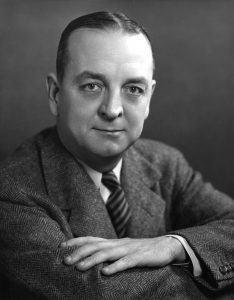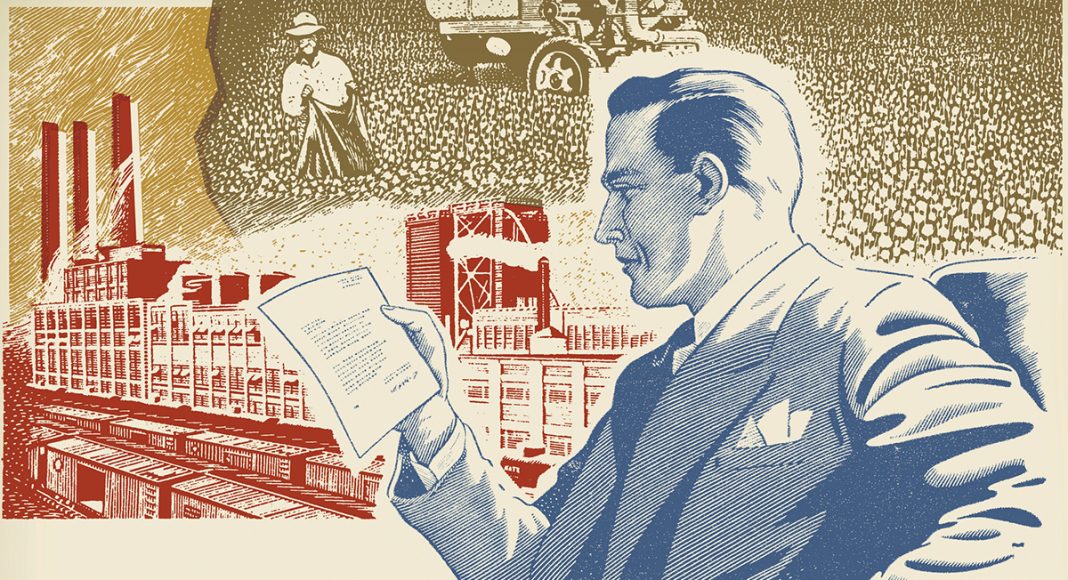The 1930s were a difficult time for classical liberals. In response to the Great Depression, the federal government undertook a massive expansion of its role in the economy. Henry Simons was passionate in his view that a new defense of liberal principles was necessary. In so doing, he outlined a positive “laissez-faire” agenda.
Editor’s note: The current debate in economics seems to lack a historical perspective. To try to address this deficiency, we decided to launch a Sunday column on ProMarket focusing on the historical dimension of economic ideas. You can read all of the pieces in the series here.
At the end of 1934, University of Chicago economist Henry C. Simons completed what he called a “propagandistic tract” designed to show that “traditional liberalism” offers both an escape from the confusions of political and economic thought prevailing during the Great Depression and a blueprint for economic reconstruction. Simons was motivated by a sense of urgency because he believed that “the cause of economic liberalism and political democracy faces distinctly unfavorable odds.” He believed that his program would receive support both from “liberals who are not naively romantic, and from conservatives who are not stupidly reactionary.” What he produced was a decidedly mixed bag from the perspective of today’s ideological and economic divides.
Simons was an “Ordoliberal.” Although the term was not in use at the time he wrote, it does describe an important characteristic of classical liberal thought that was to flower later with the work of such thinkers of the Freiburg School as Walter Eucken and Franz Böhm and in the US, notably, Walter Lippmann. Simons’s liberalism is more about the form of state governance of the economy rather than about the scope of its governance. While the two can overlap, the fundamental distinction is between clear and stable general rules of the game in contrast to discretionary, fine-tuning economic policy. Within the rules of the game the state should practice “laissez-faire.” And yet this term is somewhat misleading if the reader expects that such a state would fade into the background.
Monopoly and Perfect Competition
Simons thought that “the great enemy of democracy is monopoly, in all of its forms” (italics in the original). This one statement explains many of his proposals for reform. Let’s explore the wide implications of this. The critically important feature of a free-enterprise economy is flexible and competitively determined prices. In a sense, the term “monopoly” is a placeholder for everything that interferes with that. This includes private producer-monopolies, cartels, labor unions, protective tariffs, and minimum or maximum prices set by political authorities. Simons picked out for special criticism the National Industrial Recovery Act (1933). This Act gave the president the authority to regulate prices and wages. In accordance with this, an executive agency—the National Recovery Administration—was established to approve business and labor codes of competition with the ultimate effect of fixing prices and wages in much the same way as private cartels normally would.
Simons argued that the economic consequences of such interferences are not only inefficiencies in the allocation of resources but greater income inequality as when unions limit entry into relatively higher paying jobs and then the excluded labor must move into less remunerative occupations. The political consequences are that organized and powerful economic interest groups can “capture” the government and obtain regulatory favors. Simons was fully aware of the modern transactions costs argument, according to which organized groups have an advantage over disorganized consumers. This is a theme picked up by George Stigler and James Buchanan many years later.
Simons’s solution to this problem was draconian. “There must be explicit and unqualified repudiation of the ‘rule of reason’ [in antitrust law].” More specifically, he favored the “outright dismantling of our gigantic corporations.” He said that the Federal Trade Commission “must become perhaps the most powerful of our government agencies…”
Decades later, the “new” Chicago school of antitrust would argue for a far more nuanced understanding of what might appear to be anticompetitive activities. But the rule-oriented Henry Simons would have none of this—partly because he believed in clear-cut, simple rules, and partly because he viewed competition through the lens of the perfectly competitive model. This model painted an unambiguous picture of what competition entailed. Such a world would not have room for any sort of resale price maintenance, corporate exchange of information, one corporation owning stock in another, and, most startling, advertising. “Merchandising costs” are not only wasteful but a barrier to entry in major industries. He tentatively favored a tax on advertising expenditures. Decades later, George Stigler and other members of the Chicago school would strongly oppose this view of advertising.
“His laissez-faire was essentially advocacy of a free price system uninhibited by political or monopolistic intervention.”
Socialization of Industries
In those areas where competition was not feasible, such as the railroads and other public utilities, Simons opposed public regulation, except as a temporary expedient. He believed that the then current system of regulation was ineffective and arbitrary. In these cases, he supported outright government ownership and operation. “[T]he state should face the necessity of actually taking over, owning, and managing directly, both the railroads and utilities, and all other industries in which it is impossible to maintain effectively competitive conditions” (italics in the original).
Inequality
Simons linked all forms of anticompetitive behavior to income and wealth inequality. He believed that inequality was an important problem in American economic and political life. The “reduction of inequality is per se immensely important.” Apparently, he did not believe that eliminating or reducing the anticompetitive features of the economy would be sufficient to lessen this problem. That would require substantial changes in the tax system. “In a practical sense, there is not much now wrong with the institution of property, except our arrangements with respect to taxation.” Simons favored the abolition of sales taxes which, because of their regressive nature, worsened inequality. He said much the same about protective tariffs. In fact, he was so hostile to tariffs that he favored their abolition or massive reduction even if other nations did not reciprocate.
The major source of government revenue should be the income tax. He wanted to see radical changes in the rate structure making it more progressive “and, above all with the introduction of really substantial levies upon the so-called middle and lower income brackets.” The minimum tax rate should be 20 percent, subject to exemptions, and should rise rapidly. He did not think it was of any major importance from a revenue perspective whether the rates at the very top should be increased or not. Apparently he looked toward the federal government capturing about 10 percent of the national income through the income tax—something that seemed large then but small now. The major reform of what might today be called “loopholes” was to shift from a system of taxation based on realized gains to one which also taxed unrealized capital gains both on real property and financial assets. This would come into play especially with transfers of wealth upon death.
Simons also seemed to favor a wealth tax. (It never seemed to occur to Simons that these tax reforms could force the non-economic sale of assets and thus constitute effective interferences in the price system.) In general, any exemptions in the tax system should “be expressed in terms of amounts of tax, instead of in terms of amounts of income.” Thus, people should be exempt after a certain dollar amount of taxes had been paid.
Simons also looked forward with approval to “remarkable opportunities for extending the range of socialized consumption (medical services, recreation, education, music, drama, etc.) and, especially, for extending the range of social-welfare activities.” He characterized these as “’free income’ of the masses…made available by government either without charge or with considerable modification of prevailing price controls.”

The Great Depression
America was in the throes of the Great Depression when Simons published his tract. He blamed the Depression on the incompetence of both the Hoover and Roosevelt administrations. The policies of the two administrations were quite similar, if not in size, then in nature and quality. Both administrations thought that keeping prices and wages from falling, even in the face of contracting money supply, was a good idea. Hoover did this through “jaw-boning” with industrialists, signing the Davis Bacon Act (1931) which effectively mandated union minimum wages in all federally-funded projects, and through incentives provided through the Federal Farm Board to keep farm prices up. Roosevelt continued these and expanded the policies of interference in the price system. Simons did not mince his words: “No diabolic ingenuity could have devised a more effective agency for retarding or preventing recovery (or from leading away from democracy) than the National Recovery Act and its codes.” The flexibility of all prices and wages was an important for recovery. But the flexibility of some prices combined with the rigidity of others was a recipe for disaster.
The reform of the banking system was also a key element in Simons’s program. He was not a fan, to put it mildly, of private note issue. He favored 100 percent reserve requirements for deposit banks. Simons did not think that competition was feasible in money and, in accordance with his stand on public utilities, he thought that government should assume absolute control of the money supply. This position would be countered decades later by Simons’s fellow liberal F.A. Hayek in his own proposal for the denationalization of money.
Monetary policy during the Depression should concentrate on reflation but this should be done in a very cautious way to avoid igniting inflation. In the longer run, Fed policy should be rule-oriented. This echoes the rules versus discretion debates of decades later and in to the contemporary era. Some of the long-run options for policymakers would be a constant money supply, maintenance of the level of nominal expenditures or the stabilization of a carefully-specified basket of commodities. The precise rule was less important than that it be a rule and not a license for discretion.
Conclusions
As I wrote at the outset, Simons was an Ordoliberal. His laissez-faire was essentially advocacy of a free price system uninhibited by political or monopolistic intervention. But this required an extensive framework of government rules to restrain private entities from interfering with the formation and flexibility of prices. With respect to political interference the matter was simpler: Government should stay out. With respect to private interference, Simons was under the spell of the perfectly competitive model. He thought that its basic features were normative and that real-world competition could in many instances reflect it. Later, his fellow liberals would discuss competition as a dynamic process (Hayek, Yale Brozen, Harold Demsetz) as well as the more subtle forms that almost-perfect competitive could manifest in the real-word (Stigler).
Simons’s liberalism is about the “rule of law” and not so much about limitations on the size and scope of the state. In fact, one might fairly characterize Simons as a “big government” Ordoliberal.






